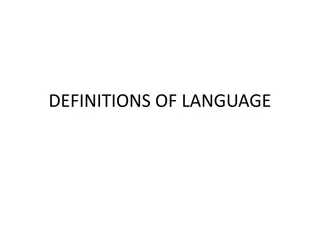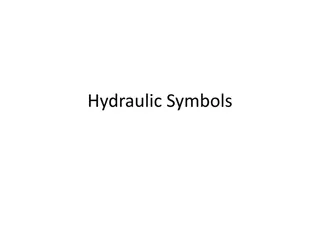Decoding Symbolic Thinking: Exploring the Power of Symbols in Learning and Perception
Delve into the world of symbolic thinking through the eyes of renowned artist René Magritte and explore how symbols shape our perception and understanding of the world. From dissecting Magritte's iconic painting to unraveling the intricacies of language as a symbolic system, journey through the interconnected web of symbols and their profound impact on knowledge acquisition and cognitive processes. Discover how symbolic thinking not only organizes our reality efficiently but also facilitates the assimilation of new meanings and connections. Uncover the significance of symbols in learning theories and gain insights into why symbolic thinking holds a crucial role in human cognition.
Download Presentation

Please find below an Image/Link to download the presentation.
The content on the website is provided AS IS for your information and personal use only. It may not be sold, licensed, or shared on other websites without obtaining consent from the author. Download presentation by click this link. If you encounter any issues during the download, it is possible that the publisher has removed the file from their server.
E N D
Presentation Transcript
Reading to Writing Exploring and Mapping the Unknown R.Chapman Kooringal High School
Representation is symbolic This is a painting by Belgian surrealist artist Ren Magritte. The text can be translated as: The Treachery: https://en.wikipedia.org/wiki/The_Treachery_of_Images This is not a pipe 1. What point is Magritte trying to make? 2. If this is not a pipe , what purpose does it serve? 3. What is he telling us about the way we experience the world around us?
Symbol A symbol is something which stands for more than itself. Symbols can be visual or aural. But this is also just a bunch of pixels which are a representation of the reality .
Language is symbolic All human language systems are symbolic. When we learn to use language, we are learning the connection between the symbol and the thing it represents . This is actually very complex and sophisticated.
Symbolic thinking and learning Do you think this is a good representation of: a) Knowledge? b) The learning process? Explain your thinking.
Symbolic thinking and learning (continued) Visit the website below and consider: 1. Which theory of learning best accommodates what you have learned about the way we think symbolically . 2. How does these theories of learning help you to further understand why symbolic thinking might be important? http://gsi.berkeley.edu/gsi-guide-contents/learning- theory-research/learning-overview/
Symbols as packets and symbols as webs Since symbols are such fundamentally interconnected things, our symbolic way of thinking allows us to: a) Organise the world in an efficient way: for example, I can pack up all the useful stuff I know about lions into a very rough symbol of a lion - this might include different contextual understandings of lion - as in the previous slide. b) Make sense of new symbolic meaning through its interconnections with what we already know Think of the way you can work out an unknown word by considering the other words in the sentence, the order of the words, the context in which the word is written or spoken.
Symbols and Dreams 1. Have you seen art like this before? 2. Does it remind you of anything? 3. What details do you notice in the image? 4. What might this painting be about? Sleep by Salvador Dali Salvador Dali Sleep 1937
Surrealist art Surrealism is a cultural movement that began in the early 1920s, and is best known for its visual artworks and writings. Artists painted unnerving, illogical scenes with photographic precision and developed painting techniques that allowed the unconscious to express itself. [Wikipedia] The Two Fridas: (https://www.fridakahlo.org/images /paintings/the-two-fridas.jpg) Frida Khalo The Two Fridas, 1939
Symbols and learning Or when you look at a painting and you can t fully grasp what it means or why it s affecting you like it is This is the boundary area where symbols operate. And as the symbols make your unconscious mind concrete, you can think about the symbols. And after thinking about them, you can articulate your thoughts. Saturn Devouring his Children: http://www.19thcenturyart- facos.com/artwork/saturn- devouring-his-children And through this process, you map out an area of the unknown, you expand your conscious mind. Goya- Saturn devouring his son
Recap 1. Language is symbolic- we communicate symbolically. 2. Symbols have meaning packed into them. 3. But they also enable us to learn about the world in an interconnected way, so we can understand new information and experiences. 4. We think in symbols- whether they are words , images or sounds . 5. Symbolic thinking is probably essential to expanding our own conscious awareness of ourselves as we grow and develop. But thinking about this last point... Does this mean that we all have to become expert dream interpreters if we want to get any smarter?
Stories as symbols A symbol is something which stands for more than itself. A shape, an object, a sound, a word But symbols can also be bigger and more complicated. Characters and stories can be seen as symbolic. Shakespeare s characters Romeo and Juliet symbolise the intensity of young love. The story of Frankenstein symbolises the dangers of science devoid of morality.
Story survivors The oldest stories within cultures have been chosen and remembered over thousands of years. Jung might say they have been remembered because they were seen as useful . Why useful ? Because they (symbolically) told some deep truth about the world. Even if people were not able to explain the symbolic meaning. In a sense, they did not need to explain it- they had the story, the story held the meaning and it could easily be passed down. (This was before English classes were invented). Jonah and the Whale Fresco Holy Monastery of Saint Nicholas Anapausas Meteora Thessaly Greece
Story survivor: Jonah This is a story which appears in the Jewish Tanakh and the Christian Old Testament. It references a time in the 8th century BCE. Read the handout which summarises the story of Jonah and suggests some archetypal symbols within the text. Jonah and the whale fresco: http://www.alamy.com/stock-photo-jonah- and-the-whale-fresco-holy-monastery-of-saint- nicholas-anapausas-65410809.html 1. What important truths do you think this story might have told to its readers over the centuries? 2. To what extent do you think these truths may have changed/ remained the same over time? Jonah and the Whale Fresco Holy Monastery of Saint Nicholas Anapausas Meteora Thessaly Greece
ACTIVITY: a) Choose at least one major symbolic element from one of the images below. b) Draft a narrative exploring the concept of transformation in which this symbol acts as a central motif. You are encouraged to be creative with your choice/ use of form. Frankenstein Boris Karloff image search Jonah and the Whale Fresco: http://www.alamy.com/stock-photo-jonah-and-the-whale-fresco-holy-monastery-of-saint-nicholas-anapausas-65410809.html























